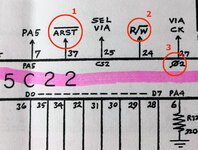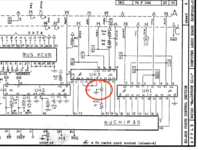geokov
Active member
Hello all,
There are some symbols on the Mac IIci Bomarc schematics that I need help with. In the image, this is part of the UD11 chip on the IIci Bomarc schematics. I have looked online for the answers but have not have luck finding the answers yet.
1. What does the line over ARST mean?
2. What is the symbol between the R and the W that continues over the W?
3. What does the circle with the line through it mean?
4. What does an asterisk after a pin or net name mean?
Thanks
There are some symbols on the Mac IIci Bomarc schematics that I need help with. In the image, this is part of the UD11 chip on the IIci Bomarc schematics. I have looked online for the answers but have not have luck finding the answers yet.
1. What does the line over ARST mean?
2. What is the symbol between the R and the W that continues over the W?
3. What does the circle with the line through it mean?
4. What does an asterisk after a pin or net name mean?
Thanks



